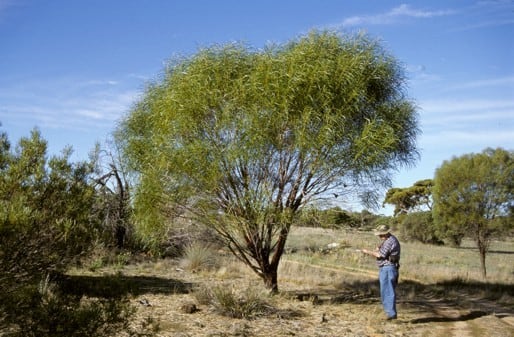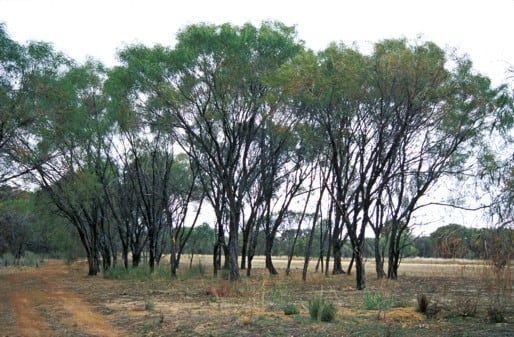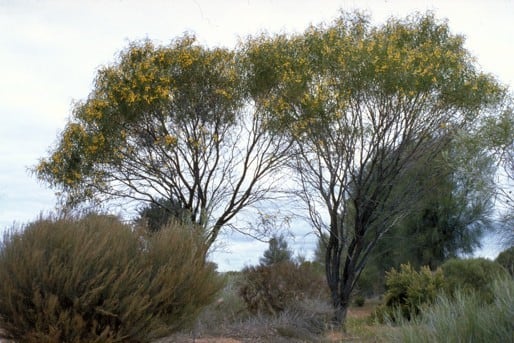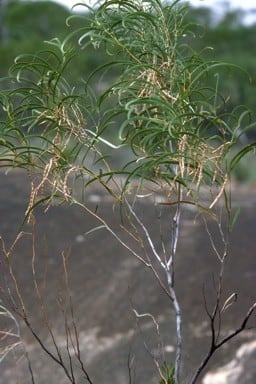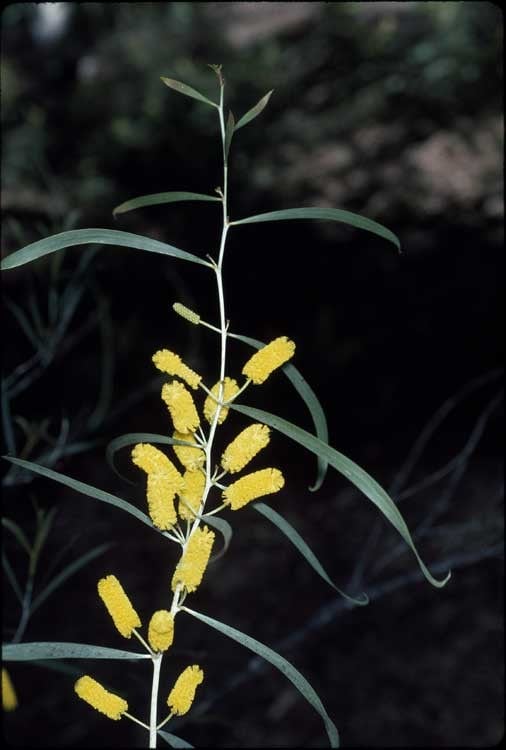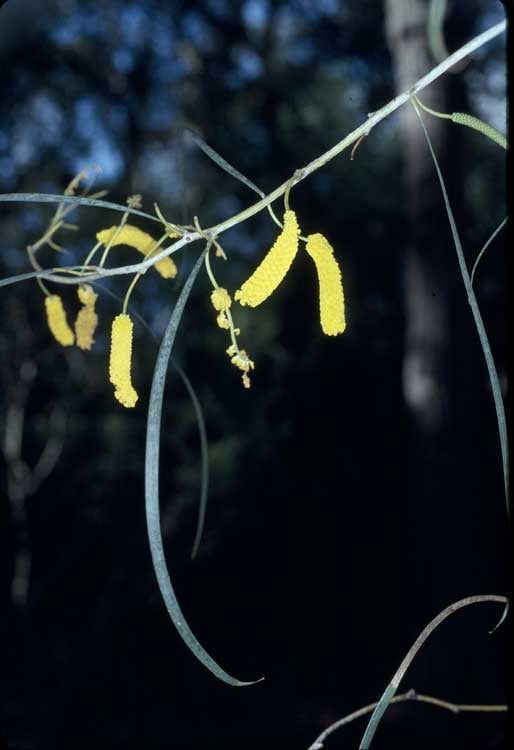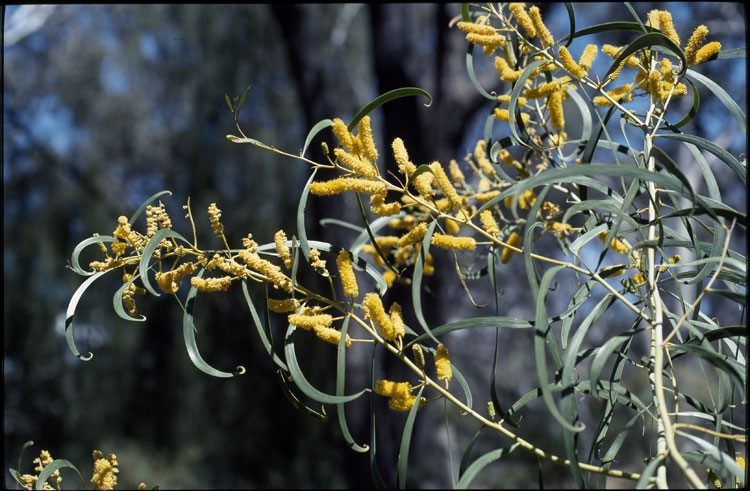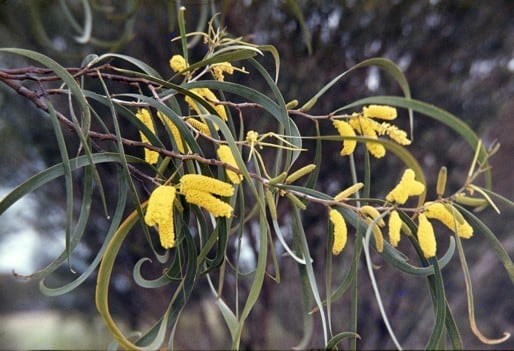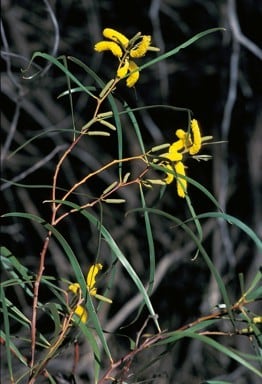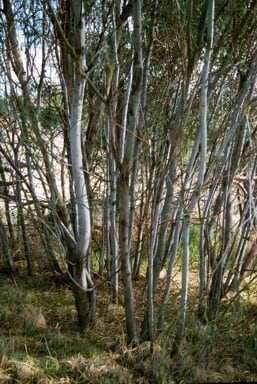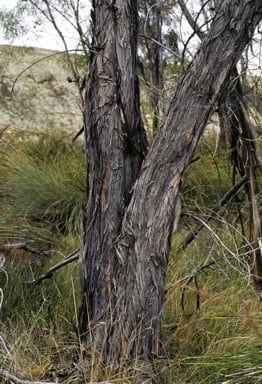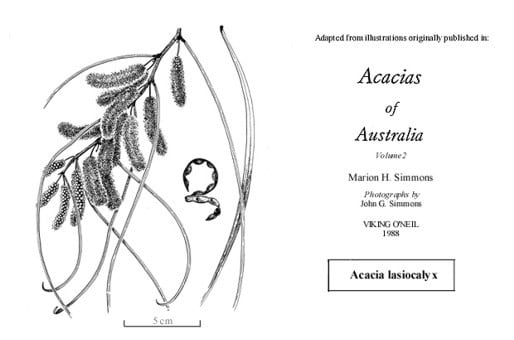Acacia lasiocalyx C.R.P.Andrews
WATTLE
Acacias of Australia
Family
Fabaceae
Distribution
Widely distributed in south-western W.A. from near Eneabba and near Kalgoorlie S to near Bremer Bay and Mt Heywood, NE of Esperance.
Description
Shrub or tree 2–3.5 m, spreading, open, glabrous; sometimes erect tree to 10 m high. Branchlets ±pruinose. Phyllodes pendent, linear, ±straight to curved with apices always obviously curved, 12–30 cm long, 2–6 (–10) mm wide, acute to acuminate, coriaceous, finely multistriate with midrib the most prominent. Inflorescences simple, sometimes a few rudimentary racemes interspersed with axes 0.5–1 mm long; peduncles paired, (5–) 8–17 mm long, pruinose; spikes 20–40 mm long, 6–7 mm diam., dense, golden. Flowers 5-merous; sepals united. Pods linear, raised over seeds and constricted between, straight to slightly curved, to 16 cm long, 4–5.5 mm wide, coriaceous, ±pruinose. Seeds longitudinal, elliptic-oblong, 5–6 mm long, glossy, dark brown; pleurogram U-shaped and much shorter than seed; funicle-aril thick and in several loops at seed-end.
Habitat
Grows in sand, gravelly sand, loamy sand, clayey sand and loam, commonly on slopes of granitic hills, granite outcrops and around such granitic sites, but also on sandplains and on laterite, in mallee woodland, mallee heath and open heath.
Specimens
W.A.: Dajoing Rock, 6.5 km NW of Wialki, T.E.H.Aplin 5970 (MO, NSW, PERTH); 46 km from Coolgardie towards Norseman, B.Barnsley 1048 (CANB, PERTH); c. 260 km N of Perth [near Arrowsmith], E.McCrum 48 (PERTH); Wittenoom Hills, S side at base, B.R.Maslin 5541 (PERTH); 12 km S of Ongerup, K.Newbey 9490 (MELU, PERTH).
Notes
Most closely related to A. conniana which has nonpruinose branchlets, generally shorter phyllodes, commonly shorter spikes and somewhat smaller pods enclosing smaller seeds with a closed or nearly closed, narrowly elongate pleurogram. Another relative is A. anastema which has free sepals (or united at the very base) and narrower pods. Also related to A. longiphyllodinea which has terete phyllodes that lack a clearly defined pulvinus and are continuous on the branchlet.
Field observations by Maslin suggest that this species forms hybrids with A. inophloia near Bendering, W.A.
Information on the biological and ecological features, and the utilisation potential, of this species is given in B.R.Maslin and M.W.McDonald, AcaciaSearch: Evaluation of Acacia as a woody crop option for southern Australia, RIRDC Publication No. 03/017, 104–107 (2004).
Plants growing at the base of granite rocks often form dense colonies and attain an arborescent habit, the main trunk more erect and straight than those of plants occurring elsewhere.
FOA Reference
Data derived from Flora of Australia Volumes 11A (2001), 11B (2001) and 12 (1998), products of ABRS, ©Commonwealth of Australia
Author
B.R.Maslin, R.S.Cowan
Minor edits by B.R.Maslin & J.Rogers
This identification key and fact sheets are available as a mobile application:
URL: https://apps.lucidcentral.org/wattle/
© Copyright 2018. All rights reserved.
